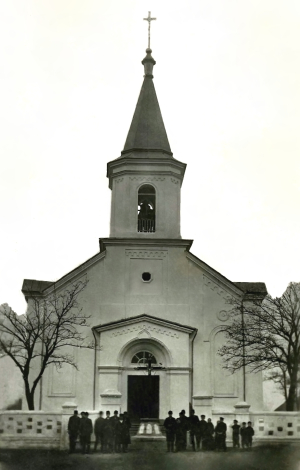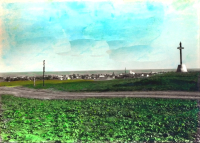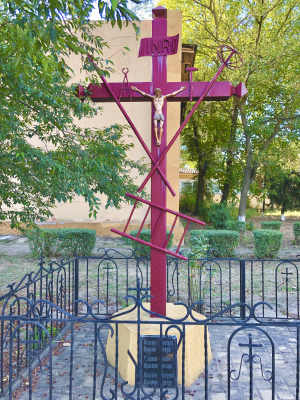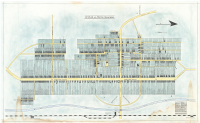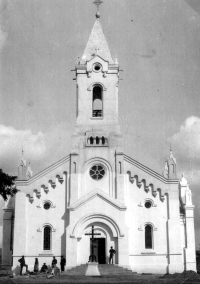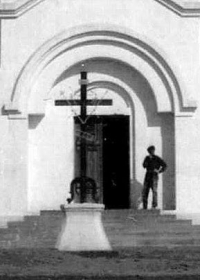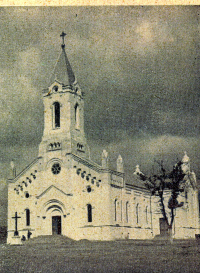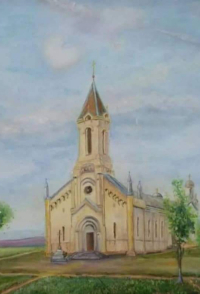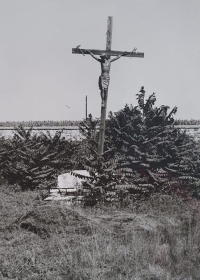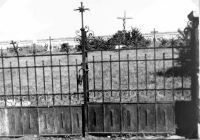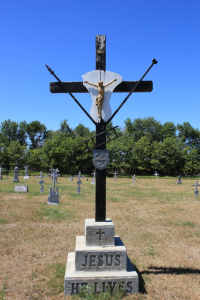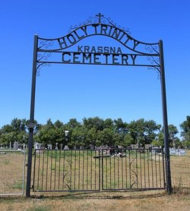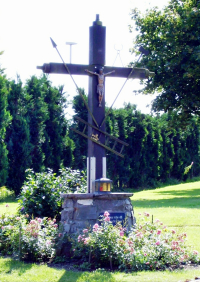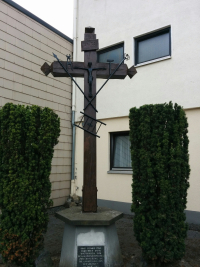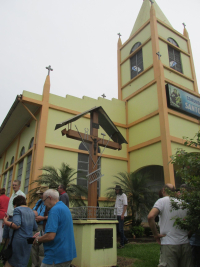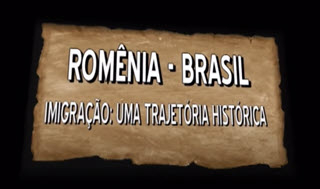_English_
User Tools
Site Tools
Sidebar
Table of Contents
Stand crosses (wayside crosses)
When the settlers arrived in the Kogälni valley in November 1814, a poor little hut stood on the empty steppe, away from the road. The shepherds Iskro, Loto & Carp lived in it.
The little money they had brought from Poland had been used up. As far as individual colonists had brought animals, many had died, many a wagon was broken. They were entirely dependent on state aid. At first, it was simply a matter of getting through the winter somehow. It was not until the next spring that the first work on developing the colony could begin: ploughing, sowing, harvesting, building houses. A makeshift shelter had to be created as protection against the inclement weather of the upcoming winter.
The area around the hut was overgrown with tall reeds on wet ground that was not suitable for digging in for the winter.
In the direction of Tarutino, about 600 to 800 m from the Kogälnik, on an elevated plain, the settlers dug themselves in for the winter. Earth huts. A rectangular depression in the earth replaces the walls. The ground-level roof above consists of supporting beams, covered with shrubbery and/or reeds, sealed with earth and/or mud. These shelters were very primitive and unhealthy. The earth pits were used to wait for spring with the animals under one roof.
There were no trees and consequently no firewood. People made do with “burian”, according to a 19th century encyclopaedia a tall steppe plant similar to grass; the word comes from Ukrainian. Several of the arrivals did not survive the first winter in the damp and cold earth pits filled with maize meal. The settlers who survived the winter made a cross from the first wood supplied for building houses and erected it next to the poor dwellings in the triangle between Katzbacher Weg and the road to Tarutino.
The special shape of the cross is known as the Arma-Christi-Kreuz described. Did our ancestors bring the special design of the cross from their homeland or did the first priest give influence? It must have pleased someone to erect such a cross. It is said that in 1940 the original cross of the first settlers still stood by the wayside.
In the early years, until the first church was built (1818), this was the place where people sent their worries, requests and needs to heaven in prayer.
After the houses were completed, the huts were dismantled and the place was turned back into farmland. The cross, which stood on a mound, was kept in memory of the first winter until the resettlement in 1940. After the harvest (end of September), the base of the cross was whitewashed every year and the cross was painted with linseed oil to protect it. On the last Sunday in September, a procession walked to the decorated cross to say thank you for the harvest and to remember the beginning and the hard winter of 1814 to 1815 with the many dead.
There were 8 wayside crosses, like the one on the roadside to Tarutino (picture), around Krasna along roads and paths.
They were the destination of processions on the so-called petition days. Eduard Ruscheinsky (teacher in Krasna) explains: “On the day of St. Mark on 25 April and on the three petition days, the petition processions were organised, but without carrying the Blessed Sacrament. The destinations of these processions were the village and field crosses. …The ecclesiastical acts were performed by the clergy at the field crosses. After visiting some of the crosses at one end of the village, the procession returned to the parish church in the same order. On the other two petition days, the crosses at the other end of the village and in the centre were visited with the procession in the same order.
The first priest of Krasna was Lukas Paschkowski. He accompanied the settlers' procession from Poland to Bessarabia. It is not known which order he was from. The following priests, sent from the Kamenetz diocese in Padolia, were of the Dominican Order or the Trinitarian Order.
- Source:
- From the book “Krasna” by Eduard Volk, born in Krasna in 1937.
- From the book “Erinnerungen” by Max Riehl, born 1927 in Krasna.
- From the essay “126 years of church life in our old homeland Krasna” by Eduard Ruscheinsky, born 1896 in Krasna.
The Arma Christi
- Lat. arma = “weapons, tools”; term for the instruments of Christ's suffering: cross, scourge, nails, crown of thorns, ladder, sponge, tongs, scourge column, rods, fetters, lance, inscription on the cross, hammer, drill, three dice, rope, board with 30 pieces of silver, robe, loincloth and shroud were venerated in the Middle Ages as symbols of Christ's sovereignty and majesty.
Arma-Christi-Kreuz - And of mediation, reflection, thanksgiving and even sometimes (indirect) worship.
- In addition, sometimes also of counter-reformation or as an alternative to the veneration of saints.
“07.01.2022:
Information from Deacon Kurt Reinelt.”
Krasna - Ukraine
Wanderer, you come here to a God-fearing village.
There were eight such wayside crosses, like the one on the road to Tarutino, around Krasna before 1940, along roads and paths.
The first wayside cross is said to have been made by the colonists with beams from the first delivery of wood for building houses. So after 1815, I cautiously estimate 1820.
A reproduction of the memorial cross was erected in the centre of Krasna in 2012. Initiative of Olga Mladinova and Dmitry Bratan Senior.
Красное сегодня - “Krasnoe Heute”
Красное утро - “Krasnoe Morgen” </ignore>
The memorial crosses remind and admonish of the common roots.
Locations of the memorial crosses...
The standing crosses were
- West
- Antschokraker-Weg corner Herrmanns-Weg
- The village was later extended beyond this old edge of the village. - On the road to Tarutino
- north
- Hinterdorfstraße Oberdorf at the end of the village towards Beresina
- Main road Oberdorf at the end of the village to Berezina
- East
- Kanzleigasse in front of the village
- after the bridge at the end of the village to Friedenstal
- South
- Hauptstraße Unterdorf at the end of the village towards Alt-Elft
- Main road Unterdorf in front of the church
Emmental - Moldova
Emmental - Pervomaisc, Causeni, Moldova
Most of the Catholic population in Emmental came from Krasna.
Cross in front of the Catholic church “Zum Heiligen Kreuz” in Emmental.
Built: 1924 - 1933
Inaugurated: 1937
Karamurat - Romania
Cross at the Catholic cemetery of St. Anthony, Karamurat, Constanta, Dobruja, Romania.
Most of the Catholic population in Karamurat came from Krasna. The standing cross was erected before 1940.
Photographer ca. 1960: Josef Speicher, born 1927 in Karamurat
Source: Rev. Johannes Florian Müller, born 1910 in Karamurat
North Dakota - USA
Holy Trinity Catholic Cemetery, Krassna, southwest of Strasburg, Emmons County, North Dakota, USA.
Founded in 1912.
However, the church's death/burial book shows the first burials in the cemetery in 1900.
Administration in 2022 at the Catholic Church of Sts. Peter & Paul in Strasburg,US-ND.
There is a large cross in the entrance area.
Created: unknown
Photo: 2012 Jim Schumacher
Bilder by Michael M. Miller on flickr
Rhineland-Palatinate - Germany
Blankenrath
Memorial cross in Blankenrath/Hunsrück, district Zell, DE-RP
left of the road to Walhausen
in memory of the old homeland.
Erected in 1952 by
The height of the base is 1.00 m, on it a 2.75 m high cross, width of the crossbeam 1.50 m.
Photo: Ernst Schäfer
and think of your soul!
Donated by the Josef Seifert family.
Mendig
Memorial cross in Mendig, Hospitalstraße 16, County Mayen-Koblenz, DE-RP in memory of the old homeland.
Erected in 1980 by
- Alois Leinz, *1918 in Krasna, concept.
The height is approx. 3.50 m with plinth, width approx. 2.30 m.
Photo: Albert Wingenbach
Built by the
Cultural Circle for
Bessarabian Germans
in memory of
the resettlement from
Bessarabia
in 1940
Itapiranga - Brazil
A copy of these wayside crosses from Krasna also stands in Itapiranga, Santa Catarina, Brazil, in front of the Saint Antonio Catholic Church there.
The cross is the symbol of the Landsmannschaft der Bessarabiendeutschen in Santa Catarina.
The cross was donated by
Erected 17.04.1994.
Carpenter Pedro Muller, son of Jorge Muller, *1921 in Krasna.
The cross is 3.00 m high, 2.00 m wide and 18 cm thick.
IN MEMORY OF OUR FATHERS
TO OUR FATHERLAND FOR SALVATION:
29-12-1932
COMUNIDADE DE SANTO ANTONIO
FUNDADA EM 21 DE FEVEREIRO DE 1948
HOMENAGEN AOS FUNDADORES:
JOSE MÜLLER - JORGE MÜLLER
JOAO LEISMANN - ANTONIO ROTHER
ALFONSO KESSLER
17.04.1994
Translated:
COMMUNITY OF SANTO ANTONIO
FOUNDED ON 21 FEBRUARY 1948
HOMAGE TO THE FOUNDERS:
Article in the newsletter of the Bessarabiendeutschen Verein e.V., Stuttgart


